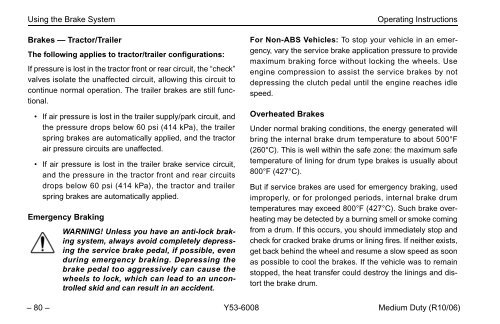Peterbilt Medium Duty Trucks Operator's Manual after 1-07
Peterbilt Medium Duty Trucks Operator's Manual after 1-07
Peterbilt Medium Duty Trucks Operator's Manual after 1-07
You also want an ePaper? Increase the reach of your titles
YUMPU automatically turns print PDFs into web optimized ePapers that Google loves.
Using the Brake System<br />
Brakes — Tractor/Trailer<br />
The following applies to tractor/trailer configurations:<br />
If pressure is lost in the tractor front or rear circuit, the “check”<br />
valves isolate the unaffected circuit, allowing this circuit to<br />
continue normal operation. The trailer brakes are still functional.<br />
• If air pressure is lost in the trailer supply/park circuit, and<br />
the pressure drops below 60 psi (414 kPa), the trailer<br />
spring brakes are automatically applied, and the tractor<br />
air pressure circuits are unaffected.<br />
• If air pressure is lost in the trailer brake service circuit,<br />
and the pressure in the tractor front and rear circuits<br />
drops below 60 psi (414 kPa), the tractor and trailer<br />
spring brakes are automatically applied.<br />
Emergency Braking<br />
WARNING! Unless you have an anti-lock braking<br />
system, always avoid completely depressing<br />
the service brake pedal, if possible, even<br />
during emergency braking. Depressing the<br />
brake pedal too aggressively can cause the<br />
wheels to lock, which can lead to an uncontrolled<br />
skid and can result in an accident.<br />
Operating Instructions<br />
For Non-ABS Vehicles: To stop your vehicle in an emergency,<br />
vary the service brake application pressure to provide<br />
maximum braking force without locking the wheels. Use<br />
engine compression to assist the service brakes by not<br />
depressing the clutch pedal until the engine reaches idle<br />
speed.<br />
Overheated Brakes<br />
Under normal braking conditions, the energy generated will<br />
bring the internal brake drum temperature to about 500°F<br />
(260°C). This is well within the safe zone: the maximum safe<br />
temperature of lining for drum type brakes is usually about<br />
800°F (427°C).<br />
But if service brakes are used for emergency braking, used<br />
improperly, or for prolonged periods, internal brake drum<br />
temperatures may exceed 800°F (427°C). Such brake overheating<br />
may be detected by a burning smell or smoke coming<br />
from a drum. If this occurs, you should immediately stop and<br />
check for cracked brake drums or lining fires. If neither exists,<br />
get back behind the wheel and resume a slow speed as soon<br />
as possible to cool the brakes. If the vehicle was to remain<br />
stopped, the heat transfer could destroy the linings and distort<br />
the brake drum.<br />
– 80 – Y53-6008 <strong>Medium</strong> <strong>Duty</strong> (R10/06)
















